
Infrasound, sometimes referred to as low frequency sound, describes sound waves with a frequency below the lower limit of human audibility. Hearing becomes gradually less sensitive as frequency decreases, so for humans to perceive infrasound, the sound pressure must be sufficiently high. Although the ear is the primary organ for sensing low sound, at higher intensities it is possible to feel infrasound vibrations in various parts of the body.

Golden moles are small insectivorous burrowing mammals endemic to Sub-Saharan Africa. They comprise the family Chrysochloridae and as such they are taxonomically distinct from the true moles, family Talpidae, and other mole-like families, all of which, to various degrees, they resemble as a result of evolutionary convergence. There are 21 species. Some are relatively common, whereas others are rare and endangered.

Animal communication is the transfer of information from one or a group of animals to one or more other animals that affects the current or future behavior of the receivers. Information may be sent intentionally, as in a courtship display, or unintentionally, as in the transfer of scent from predator to prey with kairomones. Information may be transferred to an "audience" of several receivers. Animal communication is a rapidly growing area of study in disciplines including animal behavior, sociology, neurology and animal cognition. Many aspects of animal behavior, such as symbolic name use, emotional expression, learning and sexual behavior, are being understood in new ways.
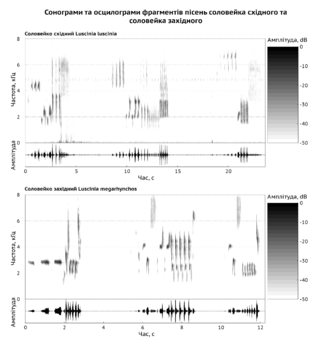
Bioacoustics is a cross-disciplinary science that combines biology and acoustics. Usually it refers to the investigation of sound production, dispersion and reception in animals. This involves neurophysiological and anatomical basis of sound production and detection, and relation of acoustic signals to the medium they disperse through. The findings provide clues about the evolution of acoustic mechanisms, and from that, the evolution of animals that employ them.

Leucorchestris arenicola, commonly called the dancing white lady spider, is a huntsman spider in the family Sparassidae and genus Leucorchestris. It is commonly found in the Namib desert of Namibia. It is often mistaken with the similarly named Carparachne aureoflava, or more commonly known as the wheel spider from the same location. L. arenicola relies on seismic vibrations, called drumming, for communication. It taps its foremost legs on the sand to send messages to other white lady spiders. Male L. arenicola will travel over 50 m in one night searching for a mate. If they find a mate, they must be extremely careful, for drumming the wrong message can be deadly. One of the major features that characterizes its nocturnal behavior is its specialized vision, using eight eyes in different orientations to capture a panoramic view of the surroundings. L. arenicola spiders use temporal summation in order to be able to see dim lighting during night-time wanderings. The species was first described by Reginald Frederick Lawrence in 1962, who described all the species in the genus Leucorchestris.

In animal communication, an alarm signal is an antipredator adaptation in the form of signals emitted by social animals in response to danger. Many primates and birds have elaborate alarm calls for warning conspecifics of approaching predators. For example, the alarm call of the blackbird is a familiar sound in many gardens. Other animals, like fish and insects, may use non-auditory signals, such as chemical messages. Visual signs such as the white tail flashes of many deer have been suggested as alarm signals; they are less likely to be received by conspecifics, so have tended to be treated as a signal to the predator instead.

Display behaviour is a set of ritualized behaviours that enable an animal to communicate to other animals about specific stimuli. Such ritualized behaviours can be visual, but many animals depend on a mixture of visual, audio, tactical and chemical signals. Evolution has tailored these stereotyped behaviours to allow animals to communicate both conspecifically and interspecifically which allows for a broader connection in different niches in an ecosystem. It is connected to sexual selection and survival of the species in various ways. Typically, display behaviour is used for courtship between two animals and to signal to the female that a viable male is ready to mate. In other instances, species may make territorial displays, in order to preserve a foraging or hunting territory for its family or group. A third form is exhibited by tournament species in which males will fight in order to gain the 'right' to breed. Animals from a broad range of evolutionary hierarchies avail of display behaviours - from invertebrates such as the simple jumping spider to the more complex vertebrates like the harbour seal.

Zygiella x-notata, sometimes known as the missing sector orb weaver or the silver-sided sector spider, is a spider species in the family Araneidae. They are solitary spiders, residing in daily spun orb webs. Z. x-notata is a member of the genus Zygiella, the orb-weaving spiders. The adult female is easily recognized by the characteristic leaf-like mark on her posterior opisthosoma, caudal to the yellow-brown cephalothorax.
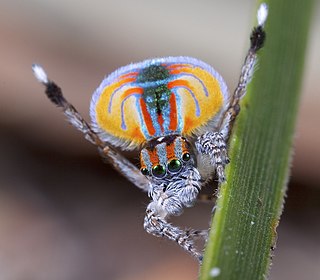
Maratus volans is a species in the jumping spider family (Salticidae), belonging to the genus Maratus. These spiders are native to certain areas in Australia and occupy a wide distribution of habitats. They have a specialized visual system that allows them to see the full visible spectrum as well as in the ultraviolet-range; this helps them detect and pursue prey. Males of this species are characterized by their colourful abdomen flaps that are used to attract females during courtship.

Aggressive mimicry is a form of mimicry in which predators, parasites, or parasitoids share similar signals, using a harmless model, allowing them to avoid being correctly identified by their prey or host. Zoologists have repeatedly compared this strategy to a wolf in sheep's clothing. In its broadest sense, aggressive mimicry could include various types of exploitation, as when an orchid exploits a male insect by mimicking a sexually receptive female, but will here be restricted to forms of exploitation involving feeding. For example, indigenous Australians who dress up as and imitate kangaroos when hunting would not be considered aggressive mimics, nor would a human angler, though they are undoubtedly practising self-decoration camouflage. Treated separately is molecular mimicry, which shares some similarity; for instance a virus may mimic the molecular properties of its host, allowing it access to its cells. An alternative term, Peckhamian mimicry, has been suggested, but it is seldom used.
Rayleigh waves are a type of surface acoustic wave that travel along the surface of solids. They can be produced in materials in many ways, such as by a localized impact or by piezo-electric transduction, and are frequently used in non-destructive testing for detecting defects. Rayleigh waves are part of the seismic waves that are produced on the Earth by earthquakes. When guided in layers they are referred to as Lamb waves, Rayleigh–Lamb waves, or generalized Rayleigh waves.

The six-spotted fishing spider is an arachnid from the nursery web spider family Pisauridae. This species is from the genus Dolomedes, or the fishing spiders. Found in wetland habitats throughout North America, these spiders are usually seen scampering along the surface of ponds and other bodies of water. They are also referred to as dock spiders because they can sometimes be witnessed quickly vanishing through the cracks of boat docks. D. triton gets its scientific name from the Greek mythological god Triton, who is the messenger of the big sea and the son of Poseidon.
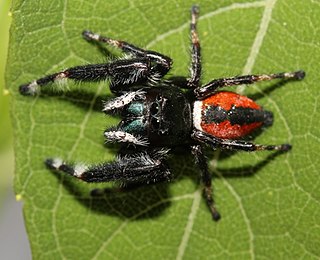
Phidippus clarus, also known as the brilliant jumping spider, is a species of jumping spider found in old fields throughout eastern North America. It often waits upside down near the top of a plant, which may be useful for detecting prey, and then quickly jumps down before the prey can escape. The spider is one of 60 species in the genus Phidippus, and one of about 5,000 in the Salticidae, a family that accounts for about 10% of all spider species. P. clarus is a predator, mostly consuming insects, other spiders, and other terrestrial arthropods.
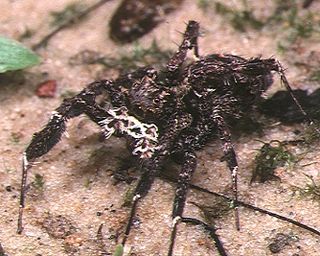
Portia fimbriata, sometimes called the fringed jumping spider, is a jumping spider found in Australia and Southeast Asia. Adult females have bodies 6.8 to 10.5 millimetres long, while those of adult males are 5.2 to 6.5 millimetres long. Both sexes have a generally dark brown carapace, reddish brown chelicerae ("fangs"), a brown underside, dark brown palps with white hairs, and dark brown abdomens with white spots on the upper side. Both sexes have fine, faint markings and soft fringes of hair, and the legs are spindly and fringed. However, specimens from New Guinea and Indonesia have orange-brown carapaces and yellowish abdomens. In all species of the genus Portia, the abdomen distends when the spider is well fed or producing eggs.
Lizards are among the most diverse groups of reptiles with more than 5,600 species. With such diversity in physical and behavioral characteristics, lizards have evolved many different ways to communicate. Lizards communicate to gain information about the individuals around them by paying attention to various characteristics exhibited by individuals and using various physical and behavioral traits to communicate. These traits differ based on the mode of communication being used.

Biotremology is the study of production, dispersion and reception of mechanical vibrations by organisms, and their effect on behavior. This involves neurophysiological and anatomical basis of vibration production and detection, and relation of vibrations to the medium they disperse through. Vibrations can represent either signals used in vibrational (seismic) communication or inadvertent cues used, for example, in locating prey. In almost all known cases, they are transmitted as surface waves along the boundary of a medium, i.e. Rayleigh waves or bending waves. While most attention is directed towards the role of vibrations in animal behavior, plants actively respond to sounds and vibrations as well, so this subject is shared with plant bioacoustics. Other groups of organisms are also postulated to either actively produce or at least use vibrations to sense their environment, but those are currently far less studied.

Habronattus pyrrithrix is a species of jumping spider in the family Salticidae. It is found in the southwestern United States and western Mexico.
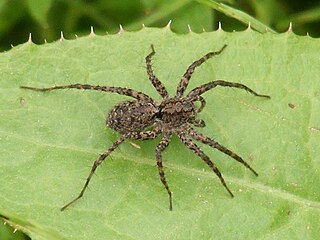
Pardosa milvina, the shore spider, is a species in the wolf spider family. They are mainly found near rivers and in agricultural areas in eastern North America. P. milvina feed on a large variety of small insects and spiders. Ground beetles such as Scarites quadriceps and large wolf spiders such as Tigrosa helluo are predators of P. milvina. P. milvina are smaller spiders with thin, long legs. This species captures prey such as arthropods with their legs and then kills them with their venom. Their predators are larger wolf spiders and beetles. P. milvina are able to detect these predators from chemotactile and vibratory cues. These spiders lose limbs when escaping from predators and they can change their preferred location in order to avoid predators. P. milvina also use chemical cues in order to mate. During their mating ritual, the male raises his legs and shakes his body. Both males and females can use silk, a chemotactile cue, for sexual communication. Additionally, female shore spiders heavily invest in their offspring, keeping them in egg sacs and carrying them for a few weeks after they are born.

Communication occurs when an animal produces a signal and uses it to influences the behaviour of another animal. A signal can be any behavioural, structural or physiological trait that has evolved specifically to carry information about the sender and/or the external environment and to stimulate the sensory system of the receiver to change their behaviour. A signal is different from a cue in that cues are informational traits that have not been selected for communication purposes. For example, if an alerted bird gives a warning call to a predator and causes the predator to give up the hunt, the bird is using the sound as a signal to communicate its awareness to the predator. On the other hand, if a rat forages in the leaves and makes a sound that attracts a predator, the sound itself is a cue and the interaction is not considered a communication attempt.

Elephants communicate with each other in various ways, including touching, visual displays, vocalisations, seismic vibrations, and semiochemicals.




















